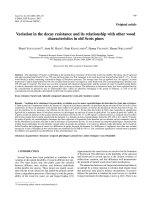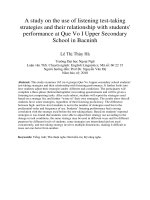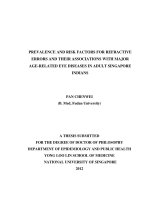Estimating micronutrient status and their relationship with other soil properties of Rewa district in Fiji
Bạn đang xem bản rút gọn của tài liệu. Xem và tải ngay bản đầy đủ của tài liệu tại đây (150.37 KB, 5 trang )
Int.J.Curr.Microbiol.App.Sci (2018) 7(1): 2808-2812
International Journal of Current Microbiology and Applied Sciences
ISSN: 2319-7706 Volume 7 Number 01 (2018)
Journal homepage:
Original Research Article
/>
Estimating Micronutrient Status and their Relationship with Other
Soil Properties of Rewa District in Fiji
H.K. Sachan1* and Deeksha Krishna2
1
Department of Crop Production, College of Agriculture, Fisheries and Forestry, Fiji
National University, Koronivia Campus, P.O.Box.1544 Republic of Fiji
2
Department of Soil Science and Agriculture Engineering, College of Agriculture, Fisheries
and Forestry, Fiji National University, Koronivia Campus, P.O.Box.1544 Republic of Fiji
*Corresponding author
ABSTRACT
Keywords
Micronutrient, soil
property, Rewa, Fiji
Article Info
Accepted:
20 December 2017
Available Online:
10 January 2018
Present study was conducted out during 2015-2016 in Rewa district of Fiji to evaluate
available micronutrient (Fe, Cu, Mn and Zn) status and their relationship with the soil
properties. Fifty seven sites were selected for soil sampling. The available micronutrient
(DTPA extractable) viz., Fe, Mn, Cu and Zn were analyzed using atomic absorption
spectrophotometer. The analyzed data revealed that available micronutrients iron (Fe),
manganese (Mn) and copper (Cu) were found to be sufficient in most of the soil samples,
whereas, available zinc (Zn) was found to be deficient in most of the analyzed samples.
Further, availability of Mn, Cu and Zn was found positively correlated with pH of the soils
whereas Fe correlated negatively with pH of the soil samples. Available Mn and Cu were
found positively correlated with EC of the soils whereas Fe and Zn correlated negatively
with EC of the soil samples. Available Fe, Mn, Cu and Zn were found positively correlated
with OC of the soils. Findings indicated that soil pH and organic carbon are the main soil
characteristics which control the availability of these micronutrients.
Introduction
Soil fertility, an important factor determining
the growth of plants is determined by the
presence or absence of plant nutrients.
Nutrients which are required in minute
quantities for plant growth are referred as
micronutrients.
Important
role
of
micronutrients in maintaining soil health and
enhancing crop yields is recognized all over
the world. Deficiency of micro nutrients has
become major constraint to agricultural
productivity, stability and sustainability of
soils (Bell and Dell, 2008). Although these are
required in minute quantities but have
significant importance as macronutrients have
and play a vital role in the growth and
development of plants.
Most of the micronutrients are associated with
the enzymatic system of plants and if deficient
subnormal growth of plant results which
sometime leads to complete failure of crop
plants. Flowering and fruiting does not take
place in severe deficiency of micronutrients.
2808
Int.J.Curr.Microbiol.App.Sci (2018) 7(1): 2808-2812
The availability of micronutrients is
particularly sensitive to changes in soil
environment and affected by organic matter,
soil pH and EC. There is also correlation
among the micronutrients contents and abovementioned factors.
acidic in nature and pH varies from 5.1 - 6.6
with low to medium organic carbon and low
electrical conductivity (0.01 - 0.08d Sm-1)
(Bell et al., 1988).
With the increased understanding of soils and
their quality attributes concept of soil health
and quality is consistently evolving. The soil
quality is managed by physical, chemical and
biological components of a soil and their
interaction (Papendick and Parr, 1992).
Fifty seven farmer fields were selected for soil
sampling. Representative soil samples were
collected considering the heterogeneity of
soils by keeping in view the variation in soil
type, slope and land use to determine chemical
properties and nutrient status. Collected soil
samples were filled in labeled zip-lock plastic
bags. Soil samples were sent to Fiji
Agricultural Chemistry Laboratory for
analysis. Samples were air dried and carefully
sieved with 2 mm diameter mesh.
Plant available micronutrients are affected by
presence of macronutrients due to either
negative or positive interactions (Fageria,
2001). Indiscriminate uses of macro nutrients
may affect uptake of micro nutrients (Dadhich
and Somani, 2007).
Soil properties are sensitive to changes in the
management and can be used as indicators to
measure soil quality (Andrew et al.,
2004).Continuous cropping, soils under
particular farming may affect soil properties
which may modify DTPA extractable
micronutrients and their availability to plants.
Keeping in view the above facts this research
was conducted to study the micronutrients
level in relation to other soil properties of the
studied area.
Materials and Methods
Soil sampling and analysis
Soil samples were analyzed for pH and EC
using EUT tech pH meter and EC 300,
respectively. The available micronutrients Fe,
Mn, Cu and Zn of soil samples were extracted
with a DTPA solution (Lindsay and Norvell,
1978). The concentration of micronutrients in
the extract was determined using atomic
absorption spectrophotometer (AAS).
Statistical analysis
The relationship between different soil
physicochemical properties and available
micronutrients were determined using
statistical software SPSS to calculate
correlation coefficient.
Location
Results and Discussion
The study was carried out during 2015-2016
in Rewa district of Fiji. The geographical
reference of the study area are 18° 05' 00" S,
178° 20' 00" E and elevation ranges from 6 to
23 m above mean sea level. The climate
condition of the study site is characterized by
wet and dry periods with most rains falling
during rainy season from November to April.
Average annual rainfall over the area is about
2,500-3,000 mm (Fiji Met, 2013).Soils are
Textural class of soils of study area was sandy
clay loam and clay loam Soil Taxonomy
(1975).The soil pH varied among various sites
from 4.9 to 7.0. The soils of the study area are
acidic in nature with the mean pH of 5.9
(Table 1) which falls under moderately acidic
rating of soil pH (5.6-6.0) (Bruce and
Raymond, 1982). Low values of pH are due to
acidic parent material, continuous rainfall that
2809
Int.J.Curr.Microbiol.App.Sci (2018) 7(1): 2808-2812
leaches most of bases throughout the year,
decomposition of organic matter further
decrease the soil pH (Miyauchi and Hayashi,
1985).
Electrical conductivity (EC) of the soils varied
from 0.02-0.70 dSm-1with a mean value 0.10
dSm-1. On the basis of limits suggested by
Muhr et al., (1965) for judging soil salt
problems, all samples were found normal (EC
<1.0 dSm-1).
This normal electrical conductivity may be
ascribed as lower base concentration and
leaching of salts from the soils. Organic
carbon (OC) values of the soils varied from
0.8 to 4.3 % with the mean value of 2.1%. 96
percent soil samples recorded organic carbon
below the range (4-10%) and found deficient
Sl.
No.
1.
2.
3.
4.
Sl.
No.
1.
2.
3.
4.
(Table 1). The range and mean values of
analyzed soil samples given in Table 1. On the
basis of critical limit suggested by Lindsay
and Norvell (1978) of DTPA extractable Iron
(Fe), 94.7 per cent soil samples were found
sufficient and 3.5 per cent soil samples were
recorded as deficient (Fig. 1). The content of
DTPA extractable Fe varied from 3-153 mg
kg-1 with an average value of 26.25 mg kg-1.
The DTPA extractable Manganese (Mn) in the
soil samples varied from 1 to 48 mg kg-1 with
the mean value of 13.14 mg kg-1 (Table 1).
Based on the critical limit suggested by Sakal
et al., (1985), 91 per cent soil samples were
found sufficient and 5 per cent soil samples
were found to be deficient in available Mn
(Fig. 1).
Table.1 The average range of micronutrients of soils
Micronutrient
Micronutrient content (ppm)
Minimum
Maximum
Average
Iron
3
153
65.28
Manganese
1
48
13.14
Copper
0.2
7
3.13
Zinc
0.1
4.2
0.94
Table.2 Critical soil test values of DTPA extractable micronutrients
Micronutrient
Nutrients content (mg kg-1)
Low
Medium
High
Iron (Lindsay and Norvell, 1978) <4.50
4.5-9.0
>9.0
Manganese (Sakalet al., 1985)
<2.5
2.5-3.5
>3.5
Copper (Lindsay and Norvell,
<0.2
0.2-0.4
>0.4
1978)
Zinc (Takkar and Mann, 1975)
<0.6
0.6-1.2
>1.2
Table.3 Correlation co-efficient values of important soil properties
Soil properties
Micronutrients
Fe
Mn
Cu
-0.101
0.153
0.302*
Soil pH
-0.141
-0.003
0.275
Electrical conductivity
0.016
0.142
0.335
Organic carbon
* indicate significance of value at P=0.05
2810
Zn
0.097
-0.013
0.072
Int.J.Curr.Microbiol.App.Sci (2018) 7(1): 2808-2812
Fig.1 Micro nutrients status of soils based on their critical range
The DTPA extractable Copper (Cu) content
of the soil samples varied from 0.2-7.0mg kg1
with mean value of 3.13mg kg-1 (Table 1).
Based on the critical limit suggested by
Lindsay and Norvell (1978), 89 per cent soil
samples were found sufficient and 4 per cent
soil samples were found to be deficient in
available Cu (Fig. 1).
The DTPA extractable Zinc (Zn) in the soil
samples varied from 0.1-4.2mg kg-1 with
mean value of 0.94mg kg-1 (Table 1). On the
basis of critical limit suggested by Takkar and
Mann, (1975) 58 per cent samples were
deficient in DTPA extractable Zn (Fig. 1) that
require Zn application for optimum
production and to get full benefit of applied
NPK fertilizers in the studied area, 23 per cent
samples were marginal and 19 per cent of the
samples were sufficient in Zn availability.
All the investigated micronutrients are
influenced by the soil environment (Lindsay
and Norvell, 1978). Soil pH has been
comprehensively identified as the single most
important soil factor controlling the
availability of micronutrients in soil.
The correlation coefficient between available
micronutrients shown in Table 3.Availability
of Mn, Cu and Zn was found positively
correlated (r=0.153, r=0.302*, r=0.097) with
pH of the soils whereas Fe correlated
negatively (r=-0.101) with pH of the soil
samples. Available Cu was found positively
correlated (r=0.275) with EC of the soils
whereas Fe, Mn and Zn correlated negatively
(r=-0.141, r=-003 r=-0.013) with EC of the
soil samples. Availability of Fe, Mn, Cu and
Zn was found positively correlated (r=0.016,
r=0.141, r=0.335*, r=0.072) with OC of the
soils (Table 3).
The
study
revealed
that
available
micronutrients iron (Fe), manganese (Mn) and
copper (Cu) were found to be sufficient in
most of the soil samples, whereas, available
zinc (Zn) was found to be deficient in most of
the analyzed samples.
Further, availability of Mn, Cu and Zn was
found positively correlated with pH of the
soils whereas Fe correlated negatively with
pH of the soil samples. Available Mn and Cu
were found positively correlated with EC of
2811
Int.J.Curr.Microbiol.App.Sci (2018) 7(1): 2808-2812
the soils whereas Fe and Zn correlated
negatively with EC of the soil samples.
Available Fe, Mn, Cu and Zn was found
positively correlated with OC of the soils.
Findings indicated that soil pH and organic
carbon are the main soil characteristics which
control
the
availability
of
these
micronutrients.
Acknowledgements
Authors are highly grateful to the Fiji
National University for providing necessary
facility to carry out this work. Thanks are also
due to the Director Research, Koronivia
Research Station for providing the laboratory
facilities to analyze the soil samples.
References
Andrew, S.S., Karlen, D. L. and Cambardella,
C.A. 2004. The soil management
assessment framework: A quantitative soil
quality evaluation method. Soil Science
Society American Journal, 68, 1945-1962.
Bell, R.W. 1988. Nutrient deficiencies in four acid
soils from south east VitiLevu, Fiji
Agricultural Journal 50, 7-13.
Bell, R.W. and Dell, B. 2008. Micronutrients for
Sustainable Food, Feed, Fiber and Bio
energy Production. IFA, Paris, France
Bruce, R.C. and Rayment, C.E. 1982. - Analytical
methods and interpretations used by the
Agricultural Chemistry Branch for soil and
land use surveys. Queensland Department
of Primary Industries Bulletin QB82004.
Dadhich, S.K. and Somani, L.L. 2007. Effect of
integrated nutrient management in soybean
–wheat crop sequence on the yield,
micronutrient uptake and postharvest
availability
of
micronutrients
on
typicustochrepts
soil.
ActaAgron.
Hungarica, 55 (2): 205-216.
Fageria, V. D. 2001. Nutrient interactions in crop
plants. J.PlantNutr., 24 (8): 1269-1290.
Fiji, Met 2013. Fiji meteorological services
/>Kinyangi, J. 2007. Soil Health and Soil Quality: A
Review. />program- leader/james-kinyangi.
Lindsay, W. L. and Norvell, W. A. 1978.
Development of DTPA soil test for Zn, Fe,
Mn and Cu. Soil Sci. Soc. American J., 42:
421 - 428.
Miyauchi, N and M. Hayashi 1985. Note on some
acid sulphate soils in Fiji. Kogoshima
University Research Centre. South Pacific
5, 175-178.
Muhr G. R., Datta, N. P., Shankara, N., Dever, F.,
Lecy, V.K. and Donahue, R. R. 1965. Soil
testing of India, 2nd Edn. US Agency for
International Development, New Delhi:
120.
Papendick, R. I. and Parr, J., 1992. Soil quality the
key to sustainable agriculture. Am. J.
Altern. Agric. 7, 2-3.
Sakal, R., Singh, A.P., Singh, B.P., Sinha, R.B.,
Jha, S.N. and Singh, S.P. 1985. Distribution
of available micronutrient cations in
calcareous soils as related to certain soil
properties, J. Indian Soc. Soil Sci., 33: 672675.
Singh, Indra Raj 2016. Micronutrient level in
relation to other soil properties of
Koronivia, Fiji. Asian J. Soil Sci., 11 (1):
155-158:
DOI:
10.15740/HAS/AJSS/
11.1/155-158.
Takkar, P.N. and Mann, M.S. 1975. Evaluation of
analytical methods for estimating available
zinc in major soil series of Ludhiana, India.
Agrochemica, 19: 420.
How to cite this article:
Sachan, H.K. and Deeksha Krishna. 2018. Estimating Micronutrient Status and their
Relationship with Other Soil Properties of Rewa District in Fiji. Int.J.Curr.Microbiol.App.Sci.
7(01): 2808-2812. doi: />
2812









